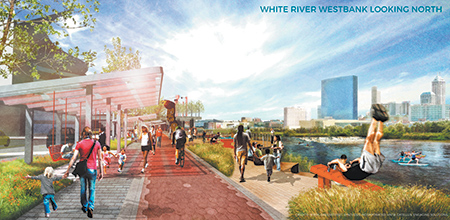Subscriber Benefit
As a subscriber you can listen to articles at work, in the car, or while you work out. Subscribe NowAn iconic architectural landmark that would be a destination and create a gateway to downtown is one of several features city officials want as part of a redevelopment of the former General Motors stamping plant site.
The entity charged with selling the 103-acre parcel along the west bank of the White River is preparing to solicit bids as early as this month and, with the city, has prepared a draft to guide development.
The city is set to unveil the framework at a Jan. 17 gathering with residents of the adjacent Valley neighborhood but provided IBJ with the document beforehand.
Besides the architectural landmark, which would connect the development to the Indianapolis Zoo via an elevated walkway over West Washington Street, the draft offers several other suggestions for the property.
 Among them: a regional riverfront park that connects neighborhoods and builds on the mass and success of White River State Park, and an infill housing strategy that addresses neighborhood stabilization and spurs development of quality housing.
Among them: a regional riverfront park that connects neighborhoods and builds on the mass and success of White River State Park, and an infill housing strategy that addresses neighborhood stabilization and spurs development of quality housing.
In addition, to help spur construction on the site, the city is prepared to extend the Cultural Trail’s Capitol Avenue leg west on South Street past Lucas Oil Stadium. And South Street ultimately would be lengthened to extend over the river and connect with the development through other road improvements.
The aim is to create a downtown neighborhood in an area that for decades has been cut off from the core largely because the river acts as a barrier, instead of a catalyst, for development.
In fact, city officials point out that the former stamping plant site is closer to Monument Circle than Fountain Square is—a fact easily overlooked because of the massive water buffer.
 Miller
Miller“If I’m a developer and I’m looking at this [guide], I’m pretty excited, because last time around they were looking at an ugly site,” said Jeff Miller, a City-County Council member whose district includes the stamping plant property.
The site became available again for redevelopment after Michigan-based RACER Trust terminated its contract in June with the Carmel-based developer REI Investments. REI had planned to build an outdoor concert venue on about half the land but couldn’t secure financing.
Two years ago, it appeared set that the $30 million, 10,000-square-foot amphitheater would occupy the site’s eastern half, and then-Mayor Greg Ballard’s planned $500 million criminal justice center would occupy the western portion. But the criminal justice project unraveled later that year amid City-County Council opposition.
This time, however, RACER is marketing the site for residential, retail and commercial uses to capitalize on growing interest from developers that envision a large-scale project encompassing the entire site.
 Rasher
RasherRACER has had contact with 70 developers, including local, regional and national players, before even soliciting proposals, Bruce Rasher, RACER’s development manager, said.
“We think conditions are excellent right now,” he said, “so we should get some exciting offers.”
RACER, or Revitalizing Auto Communities Environmental Response, was established in 2011 to coordinate the redevelopment of old General Motors Corp. properties following the auto manufacturer’s bankruptcy.
The high interest in the property from developers is partly due to the city’s efforts to make it more marketable. In December, the City-County Council expanded the downtown tax-increment-financing district to include the stamping plant property and the Market East Cultural District.
 TIF districts capture incremental property-tax revenue generated by new development to pay down debt issued to spur economic development projects. Since the downtown TIF was created in 1982 to kick-start the rebirth of the urban core, it has helped fund a long list of developments—from Circle Centre mall to Flaherty & Collins Properties’ $121 million apartment tower going up on part of the former Market Square Arena site.
TIF districts capture incremental property-tax revenue generated by new development to pay down debt issued to spur economic development projects. Since the downtown TIF was created in 1982 to kick-start the rebirth of the urban core, it has helped fund a long list of developments—from Circle Centre mall to Flaherty & Collins Properties’ $121 million apartment tower going up on part of the former Market Square Arena site.
The city said TIF funds could go toward road construction, not only to improve connectivity but to break up the vastness of the property and give it more of a neighborhood feel.
Roadwork likely would be done in phases to make the site “more bite-sized,” said Jeff Kingsbury, managing principal of Greenstreet Ltd., a local real estate development, brokerage and consulting firm the city hired to help craft site plans.
The city would create a grid in part of the site by extending Division Street to the north and under the railroad to link with White River Parkway at Washington Street. The link would provide connectivity south to the Eli Lilly and Co. Technology Center and north to IUPUI and the planned 16 Tech innovation district, the city’s draft says.
 Cook
CookIn addition, an east-west spine road is planned to link the site to the Interstate 70/Harding Street interchange to the west and downtown to the east via South Street. Also, Oliver Avenue would be realigned to connect with McCarty Street east of the river.
Leaders of The Valley neighborhood are excited about the prospects.
“But we also want to make clear that this would not only benefit our neighborhood but could set in motion events that would lead to a truly positive transformational change for our entire city,” Rahnae Napoleon, president of The Valley neighborhood association, said in an email.
The city, in drafting the framework for the site, stopped short of suggesting specific development in an effort to encourage creativity, said Thomas Cook, Mayor Joe Hogsett’s chief of staff.
“We put something in place to give our city’s vision of what that site can produce,” he said. “We don’t want to close doors; we want to open them.”•
Please enable JavaScript to view this content.

